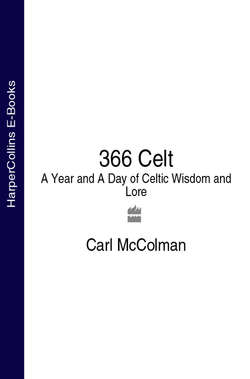Читать книгу 366 Celt: A Year and A Day of Celtic Wisdom and Lore - Carl McColman - Страница 6
INTRODUCTION
Оглавление“IN CONVERSATION THEY SPEAK IN RIDDLES, FOR THE MOST PART HINTING OF THINGS AND LEAVING A GREAT DEAL TO BE UNDERSTOOD.”
Thus did the classical writer Diodorus Siculus describe the druids, the original keepers of Celtic wisdom and lore. What we mostly know about the druids reveals just how much we do not know: we know they did not write down their lore, we know that they were not only spiritual leaders but also scientists/intellectuals; and yet even so we know that they were the ritual priests, the soothsayers, and the interpreters of omens. And apparently, they did it all with a rollicking good humor, and uncanny ability to speak in oblique and mysterious ways.
The Celtic world is a world of poetry before philosophy; of mysticism before theology; of magic before logic. Storytelling matters more than the ability to explain something in dry, step-by-step detail. The Celts are, and always have been, a people with one foot in the otherworld, and thus are governed by the enigmatic conventions and customs of that spiritual realm: where time is meaningless, love is forever, and dancing just might never ever end.
The book you’re holding is written with the spirit of the old druids in mind. Riddles and hints matter more here than direct explanations or matter-of-fact descriptions. This is a book of meditations, but what does that mean? Some of the pages that follow invite you into a world of fairies and goddesses; others sneak significant symbols past you in the guise of a summary description of this or that aspect of the tradition. There are 366 pages of thoughts and ideas and invitations into the inner world—read them a day at a time, or get wild and swallow up a week or even a month at a single sitting. I decided to number the entries, rather than date them—daily meditation books seem so structured and tight, if you read “May 17” on any other day it’s just, well, wrong. That, of course, is an invitation to utter chaos, at least as a riddle-talking Celt sees it. So I decided to circumvent the chaos and give each reader the freedom to explore these 366 “morsels” in whatever way works best for you.
The entire collection is organized in 40 different “paths,” each one consisting of 3, 9, or 21 meditations. No one path is required as a prerequisite for any of the others. Once in a while paths crisscross and you’ll encounter the same figure or event that you bumped into three or four paths back. The Celtic tradition just kind of works that way.
Feel free to jump around between the paths, or even within any one path. Read these pages in order, or not. The choice is yours. 366 pages later, you’ll have covered a nice slice of the Celtic terrain. And you’ll still be an absolute beginner in the world of the Celts. Listen to the druids: they’ll have more riddles to offer you. Some will open up amazing shafts of light that will illuminate and inspire you. Others will leave you scratching your head and wondering, “Huh?” That, too, is part of the territory.
May the blessings of the four directions, the three realms, the two worlds, and the one source fill all your days with laughter and joy.
Carl McColman
Summer Solstice 2004
Note on spelling: The names of Celtic deities and heroes can be spelled many different ways. For the sake of simplicity, I have chosen to conform to the spelling found in MacKillop’s Dictionary of Celtic Mythology (Oxford University Press, 1998). Brigit poses a unique problem since both a goddess and a saint bear the same name. Following MacKillop, in this book I have identified the goddess as “Brigit” and the saint as “Brigid.”
